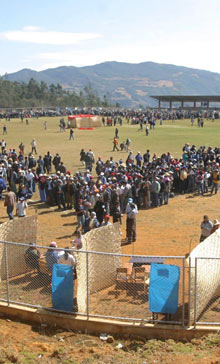Mining in Peru
Revolt in the Andes
September 20th, 2007 - from The Economist print edition
A vote of sorts against big mines
LIMA, Peru –MANY of the world's top mining companies have made big investments in Peru and are now ramping up output just when world prices for minerals are at record highs. The government has handed out concessions for exploration covering 12m hectares (45,000 square miles), which it hopes will trigger further investment of $11 billion over the next four years. The industry is booming, as is the economy. But in the Andean highlands that contain the mineral deposits, some Peruvians are turning against the mining companies.
 (right) Not in our backyard, please. photo from EPA.
(right) Not in our backyard, please. photo from EPA.
The latest battle is at Rio Blanco, a remote spot close to the border with Ecuador where the Andes meet the Amazon, forming a misty cloud forest. Monterrico Metals, a London-based start-up recently sold to China's Zijin Consortium, plans to develop a huge copper mine there, costing $1.4 billion. Urged on by a loose coalition of environmentalists, Catholic priests and foreign NGOs, local mayors have campaigned against the project. On September 16th they held an unofficial referendum in the three affected districts. Of the 17,971 votes cast (a turnout of almost 60%, said the organisers), all but 984 voted against the mine.
Opponents say the mine would pollute rivers that are vital for farmers in fertile valleys lower down and accuse the company of ignoring local opinion. More broadly, they argue that mining has failed to develop the highlands. President Alan García's government denounced the referendum as unrepresentative and claimed its organisers were “communists”.
At Rio Blanco genuine fears and grievances have been mixed with much misinformation and political manipulation, a familiar pattern in Peru. The local mayors say they now want talks on the project. Richard Ralph, Monterrico's chairman, welcomes this as a chance “to dispel some of the myths about a mine that hasn't even been built”. He says that the project will use clean, modern mining technology and very little water, which it will not pollute. The company has promised the few thousand villagers who live close to the mine a community-development fund of $80m over the next three decades.
Monterrico hopes that work on the mine can still start next year, after an environmental-impact study is completed. Other mining companies in Peru will be watching closely. In recent years the industry has tried to clean up its image. But it labours under a legacy of poor environmental practice (some of it when the big mines were state-owned in the 1970s and 1980s). Conflicts between farmers and miners over water use are particularly common.
Modern mines may be much cleaner but they are capital-intensive and generate relatively few jobs. Some economists argue that mines could do more to boost surrounding areas by using local suppliers: one study found that in northern Chile each mining job generates seven others, while the figure in Peru may be lower.
 In response to the protests, mining companies are spending more on community development. Half of their income taxes are also returned as local royalties. But local governments often make a bad job of spending this money. And in Apurímac, one of Peru's poorest regions, the national government has rejected all the projects proposed by local communities that would draw on a $40m fund set up by Xstrata, a Swiss firm developing a copper deposit at Las Bambas.
In response to the protests, mining companies are spending more on community development. Half of their income taxes are also returned as local royalties. But local governments often make a bad job of spending this money. And in Apurímac, one of Peru's poorest regions, the national government has rejected all the projects proposed by local communities that would draw on a $40m fund set up by Xstrata, a Swiss firm developing a copper deposit at Las Bambas.
“Mining companies are making huge sums of money right now, but...the average person living near a mine does not see any benefits,” complains Victor Madariaga, who heads the chambers of commerce in southern Peru. In Cajamarca, the site of Yanacocha, a big gold mine, six out of ten residents are still poor (though that figure is lower than a decade ago and includes areas far away from the mine).
Others argue that by focusing on mining's impact on the local economy, the critics miss the point. Mining provides much of Peru's foreign exchange and tax revenues. Some Peruvians argue that more of the windfall from high prices should be taxed: mining's total tax bill was around $2.9 billion last year on net profits of some $7.3 billion, according to the mining society. Taxes have been edging up: the previous government imposed a royalty of up to 3% on new projects; Mr García negotiated a further “voluntary contribution” of 3% of the industry's after-tax profits (raising some $175m this year).
With or without mining, parts of the Andes will remain poor. But with it, Peru's economy can continue to grow fast. For that, the government will have to do more to engineer a modus vivendi. It is looking at reining in labour sub-contracting in the industry. But it has yet to take what is perhaps the most important step: remove environmental regulation of the industry from the mining ministry and vest it in a specialist environmental agency. The future of mining in Peru depends on the government acting as an effective referee. The days when mines could ride roughshod over the locals are well and truly over.